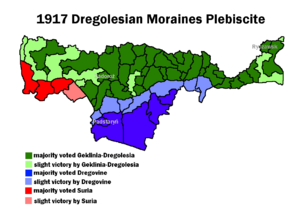Geklinia-Dregolesia
| United Kingdom of Geklinia-Dregolesia Zjednoczone Królestwo Żeklinii-Dregolezji Об'єднане Королівство Жеклінії-Дреголесії | |||
|---|---|---|---|
| |||
Loading map... | |||
| Motto: "Zjednoczneni i niepokonani Єдиний і непереможений" United and undefeated | |||
| Capital | Dobrzanka | ||
| Official languages | Lechian, Dregolesian, Podolian and Zamednovchan | ||
| • Regional languages | Lanian Lechian, Kalmish, Dregovnian | ||
| Demonym | Geklin-Dregolesian | ||
| Government | Federal parliamentary semi-constitutional monarchy | ||
| Area | |||
| • Total | 138108.29 km2 53323.91 sq mi | ||
| Population | |||
| • Estimate | 12,269,420 | ||
| GDP (PPP) | 2019 | ||
| • Total | 410.672 billion $ | ||
| • Per capita | 33,476.6 $ | ||
| HDI (2022) | very high | ||
| Timezone | WUT +5h | ||
| Currency | Nedelican Universa (Ʉ or NDU) | ||
| Drives on the | right | ||
History
Prehistory
Early History
Middle Ages
Industrialisation
Turbulent Times
In early February 1912, the Lido-Dregolesian militia captured Mirgorod and Chashavinsk. Not a whole month later, on March 15th 1912, the Republic of Dregolesia separated from Lido under the lead of Oleg Syvirianovich. However, the newly formed state was very unstable and quickly after fell into a civil war. On 11th of June 1912, monarchist forces supported by the Kingdom of Geklinia took control over northern territories, establishing a Kingdom of Northern Dregolesia. 4 days later, on 15th of June 1912, anarchist forces rose up south of Molvaty mountains, but failed to capture any major city. Communist revolutionaries rose up on 29th of June 1912 in the industrialized region of Bir and Mizhrichkavsk. The nationalist government managed to defend the most important cities, including the state's capital - Chashavinsk. On 23rd of July 1912, the communist militia organized the Mezhova massacre, where 298 men were caught, sentenced for treason against the communist regime and murdered. The Kingdom of Northern Dregolesia managed to secure major part of Chashavinsk-Ivaniv railway line, which was crucial for the nationalist army on the coast. The Anarchist army finally managed to break nationalist defences in Rychavsk and captured the city on 31st of August 1912, not long after, they were met with communist revolutionaries coming from the north. Bloody battles took place in the suburbs of the city, that lasted for several weeks, when the anarchists, without much support had to retreat and leave the city on 21st of September 1912.
War with neighbours > United Geklinia-Dregolesia > Plebiscite > Currency
Modern Era
Economy
As of 2022, the economy of Geklinia-Dregolesia is the biggest in the Nedelica Union and one of the biggest on the southern Great Sea coast. The unemployment rate is 4.5% according to Królewski Urząd Statystyczny (Royal Statistics Office). The majority of working population works in the service sector, every third - in manufacturing and every tenth in agriculture.
Geklinia-Dregolesia uses the Nedelica Universa (NDU, Ʉ), which is used in the Nedelica Union countries since 198x, it replaced the Geklin-Dregolesian Universa used since 1919. The nominal GDP of Geklinia-Dregolesia is worth 233.945 billion $ or 19070.4 $ per person.
The most powerful company of Geklinia-Dregolesia, Ulano Group was established in 1829 by Ryszard Ułanowski, at the time called Ułanowski Trading Company. Low competition on the newly independent Geklinia has allowed Ułanowski to expand his company across more fields, such as hotel industry in 1845 or textile manufacturing.
Rebuilding the country after the Great War provided great conditions for some companies to rise. Ułanowski Trading Company has rebranded and restructured to Ulano Group with several subsidiaries, at the time the most notable one being food and material trade branch, as those were desperately needed in regions destroyed by the war. Ułanowski family got several grants from the government, that today are estimated to be equivalent to 311 million $. This has played major role in further expansion of an already big corporation. In 1952, Ulano had invested in expansion of iron production in central Dregolesia, managing to keep a lot of income from it. This was the case until 1965, when the 1965 Dregolesian Revolution gave the government a good opportunity to seize a lot of assets from private hands. Since then the biggest players from Ulano Group were Ulano InCo, responsible for trading and managing construction projects, and Ulano Insurance, which became a trusted insurer for the citizens. Statistics by INEiF from 2021 show that Ulano Group produced a total worth 153 billion $ of revenue and was responsible for 31% of Geklin-Dregolesian GDP.
Infrastructure
| Infrastructure of Geklinia-Dregolesia | |
|---|---|
| Driving side | right |
| Railways | |
| • Passing side | right |
| • Gauge | 1435mm |
| • Electrification | 3kV |
| Mains electricity | 230V 50Hz |
| Telephone code | +28 |
| Internet TLD | .gd |
Railways
Geklinia-Dregolesia has a dense railway network. The majority of tracks are standard gauge, however there still exists few hundred kilometres of narrow gauge lines. The owner of almost every standard gauge railway line is the state-owned company called Royal Railway Lines. Passenger and freight services are done by several regional operators.
| name | region | service types | founded/defunct in |
|---|---|---|---|
| Koleje Żeklińskie 'Geklin Railways' |
Nationwide | passenger trains | 1990 |
| Дреголесійська Регіональна Залізниця 'Dregolesian Regional Railways' |
Dregolesia | passenger trains | 1990 |
| Istoĉni Ẑalezni Puty 'Eastern Railway Company' |
Zamednovcha | passenger trains | 1990 |
| GekDregCargo | Nationwide | freight trains | 1990 |
| Królewskie Przewozy Kolejowe 'Royal Railway Transport' |
Nationwide | all | 184x/1990 |
| Дреголесійська Залізниця 'Dregolesian Regional Railways' |
Dregolesia | all | 1912/1918 |
One of the biggest rail rolling stock manufacturers in the world, Ulano Rail S.A., was founded in Geklinia-Dregolesia in 1934. The company grew significantly after acquiring new production plants and later merging with Cabelian manufacturer Lorande SA and renaming itself to Ulano-Lorande SA. As of June 2023 Ulano-Lorande has 11 production lines worldwide, producing rolling stock for countless tram, metro and railway systems.
Roads
The road network of Geklinia-Dregolesia comprises six highways, several expressways, and many lower-classification roads.
Airlines
In its history Geklinia-Dregolesia had two major aircraft manufacturers. The first most prominent one was Tazowskie Zakłady Awiatorskie, which existed from 1921 until its bankruptcy in 1949. TZA has produced both military and civilian aircrafts. After the Great War, a Plavativ manufacturer Mikhail Hordiyenko rose to dominate the market with his company co-owned by Plevian engineer … Sabbalini.
Since 1982 there is only one airport handling intercontinental flights, the International Airport Geklinia-Dregolesia, located southwest of Mizhrichkavsk, on the border between Geklinia and Dregolesia. Prior to construction of it, both Dobranka and Chashavinsk each handled international flights on their local airports. Other major cities like Moremir, Bogan and Nedelica have their own airports.
The national carrier is GeDe Air, established in 1981 as a merger of former GekLines and Aviakompaniya Dregolot. It operates flights from all national airports. Another big player in airline industry is Air Nedelica, a low-cost carrier flying between the countries of the Nedelica Union.
Demographics
In June 2023, Geklinia-Dregolesia's population was estimated to be around 16.2 million by the Royal Statistics Office, with the fertility rate slowly declining in recent years. Since 2021, when the recorded fertility rate was 1.79, it has dropped to 1.71 children per woman in 2023. The country's population is centered around big urban areas, as over 5 million people reside in the metropolitan areas of the biggest cities. Overall population density is around 122 inhabitants per sq kilometer. The government of Geklinia-Dregolesia is trying to stop the urbanization of the country by various pro-agricultural social programmes and laws.
The major hubs of Geklinia-Dregolesia are Chashavinsk (1.6 million), Dobranka (1.2 million), Moremir (0.8 million), Bogan (0.6 million) and Nedelica (0.5 million). These five urban centres create the core of the kingdom's transportation network.
Geklinia-Dregolesia is in majority formed by two nationalities: Dregolesians and Geklin-Lechians. The former slightly outnumber Geklin-Lechians by around one million people, this has caused serious issues in the past, as the power was held by the smaller group of people. This has changed after 1965 Dregolesian Revolution, which brought major changes to the country's government structure. From then on, there has been a lot of pressure to popularize a Geklin-Dregolesian identity with which citizens could represent themselves. On the most recent statistics 73% of the population declare themselves as Geklin-Dregolesians, with 63% choosing Geklin-Lechian as a subidentity, 28% Dregolesians and the remaining 5% choosing other minority subidentities.
The kingdom has seen a drop in immigration since early 2000s. Before that it has been a destination for Surians and Dregovnians, but since the economic situation in these countries is equalizing to that of Geklinia-Dregolesia, less and less people come to work in the country. The trend is reversed when it comes to emmigration. In search of better living standards, Geklin-Dregolesians often emmigrate to countries such as Lechia, Plevia or Ohemia. According to KUS, in 2023, around 4000 people immigrated to UKGD, while around 13000 emmigrated to a different country.
| Rank | City | County | Population in 2013 | Population in 2023 | Growth | km² | mi² |
|---|---|---|---|---|---|---|---|
| 1 | Chashavinsk | City of Chashavinsk∈⊾ | 1,499,749 | 1,594,233 | 6.3% | 430.7 | |
| 2 | Dobranka | Royal Capital City of Dobranka∈⊾ | 1,053,326 | 1,180,779 | 12.1% | 265 | |
| 3 | Moremir | City of Moremir∈⊾ | 746,660 | 814,606 | 9.1% | 372 | |
| 4 | Bogan | City of Bogan∈⊾ | 497,766 | 566,458 | 13.8% | 242.6 | |
| 5 | Nedelica | City of Nedelica∈⊾ | 542,535 | 523,546 | -3.5% | 162.7 | |
| 6 | Rychavsksk | City of Rychavsk∈⊾ | 313,840 | 322,628 | 2.8% | 134.9 | |
| 7 | Tazów | Tazów County∈⊾ | 317,232 | 309,301 | -2.5% | 134.6 | |
| 8 | Śwjyntoprykopice | Śwjyntoprykopice County∈⊾ | 248,002 | 248,746 | 0.3% | 117.9 | |
| 9 | Mizhrichkavsk | Mizhrichkavsk County∈⊾ | 127,177 | 130,738 | 3.8% | 123.4 | |
| 10 | Ivaniv | Ivaniv County∈⊾ | 122,213 | 110,847 | -9.3% | 122.5 | |
| 11 | Bir | City of Bir∈⊾ | 117,927 | 105,663 | -10.4% | 210 | |
| 12 | Żabiniec | Żabiniec County∈⊾ | 101,903 | 95,585 | -6.2% | 91.8 | |
| 13 | Zadorozh | Zadorozh County∈⊾ | 83,371 | 89,791 | 7.7% | 106.2 | |
| 14 | Podwiyrch | Podwiyrch County∈⊾ | 90,041 | 88,420 | -1.8% | 66.7 | |
| 15 | Zygmuntów | Dobrzanka County∈⊾ | 66,960 | 69,906 | 4.4% | ||
| 16 | Plavativ | Plavativ County∈⊾ | 58,658 | 60,242 | 2.7% | ||
| 17 | Gorodishche Chashavinske | Eastern Chashavinsk County∈⊾ | 60,368 | 59,221 | -1.9% | ||
| 18 | Nishla | Nishla County∈⊾ | 57,712 | 55,519 | -3.8% | ||
| 19 | Novovajsk | Zheran' County∈⊾ | 52,310 | 53,356 | 2.0% | ||
| 20 | Łany Dobrzańskie | Dobrzanka County∈⊾ | 49,550 | 52,672 | 6.3% | ||
| 21 | Ridkiv | Ridkiv County∈⊾ | 55,688 | 50,899 | -8.6% |
Climate
Culture
Holidays and traditions
Sports
Cuisine
Geklin-Dregolesian cuisine shares similarities with its neighbouring countries. Most notable regional dish is pierogi, in Geklinia filled with mashed potatoes and cheese and in Dregolesia called 'varenyky', they're often filled with mushrooms and sauerkraut. Soups are also a common part of the national cuisine, the most popular one being the chicken soup and pickle soup.
Among the most popular desserts in Geklinia-Dregolesia are cheesecake (sernik/syrnyk) or a specific type of a cream pie called kremówka/kremovka.


